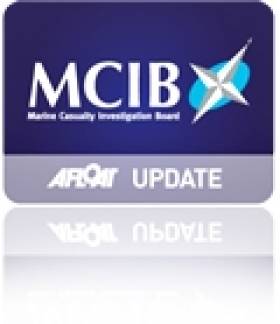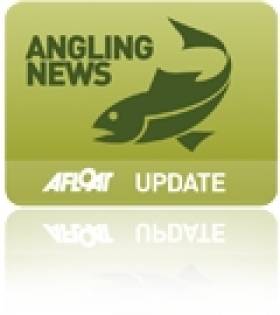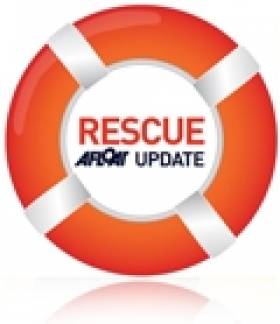Displaying items by tag: Lough Corrib
Safety Measures Highlighted In Report On Angler's Death
#MCIB - The Marine Casualty Investigation Board (MCIB) has again advised recreational boat users to prioritise safety while on the water following the death of an angler on Lough Corrib earlier this year.
Clarifying the story previously reported on Afloat.ie, Michael Ruane died by drowning after he and angling partner Donal Coyle were knocked overboard from their small craft when it heeled over on a large wave off Annaghdown on 19 March 2012.
Coyle was treated for hypothermia after an unsuccessful attempt to search for his colleague, whose body was recovered by the Irish Coast Guard more than two hours after he entered the water.
The MCIB report into the incident found that the revolving seat used by one of the two men on board meant that "both his height above the gunwale and his position right forward may have had an influence on the handling and stability of the boat", which was not compliant with the EU Recreational Craft Directive.
It also found that while both were wearing personal flotation devices (PFDs), they were only loosely fitting - explaining why Ruane became separated from his lifejacket shortly after going overboard.
Moreover, the kill cord on the boat's engine was not used by either man, which caused them to be separated from their vessel. "The consequence of this," the report said, "was a long period of immersion in cold water which led to the death of one of the men and hypothermia of the other".
There was also a delay of more than an hour in raising the alarm as the men in the water had no means to indicate their distress. Coyle had a mobile phone but it was rendered useless by immersion.
The MCIB has recommended that owners and operators of recreational craft should be aware and follow the Department of Transport, Tourism and Sport’s (DTTAS) Code of Practice for the Safe Operation of Recreational Craft. The complete report is available to download below.
Meanwhile, problems with the auto-pilot system were judged to be the trigger of events that caused the scuttling of fishing vessel Jeannete Roberta in Glandore Harbour last December.
The prawn boat was returning to port on 11 December 2011 when the skipper had difficulty switching the helm from auto-pilot to manual due to a known issue with "sticky solenoids".
While the skipper addressed that issue, the boat suddenly altered course without warning - another issue known to occur randomly - and was holed on rocks on the southern side of Adam's Island before eventually sinking.
While castigating the owner/skipper for continuing to sail the vessel with persistent navigation issues, the MCIB also noted that all six crew survived the incident uninjured, finding that all stayed calm and organised as they abandoned ship, and that all safety and communications equipment functioned as required.
#ANGLING - A big month for angling in Ireland continues in Galway, as the biggest ever fish caught on the Western lakes now has a permanent home in Clonbur.
As previously reported on Afloat.ie, Welsh fly fisherman Ceri Jones hooked the 24lb monster trout from Lough Corrib at the end of May.
After authentication by the Irish Specimen Trout Committee, the goliath fish has been declared the biggest catch on record in all of Ireland since 1894, when William Mears landed a 26lb brown trout at Lough Ennell.
Fly Fishing Cork reports that the fish now has pride of place above the bar at Tigh Bhurca in Clonbur, joining a 19lb giant that Jones himself caught a few years ago.
“There was never a question of the fish going anywhere else," he says of the new home for his record-breaking catch. "I got an opening offer of $5,000 from an American who collects such catches but I’d never even consider selling it.
"Clonbur is where the fish should stay and we’ve completed that part of the jigsaw by handing it over here tonight. I got local taxidermist John Thomas from Headford to stuff it and now it’s where I always want it to be.”
Fly Fishing Cork has more on the story HERE.
Corrib Anglers Donate to Rescue Boat
#ANGLING - Days after the tragic death of an angler on Lough Corrib, as previously reported on Afloat.ie, the Collinamuck Angling Club will donate €5 from every entry in the upcoming open wet fly competition on 22 April to the Corrib Mask rescue boat.
"The important work that is carried out by the volunteers of the Corrib Mask rescue boat is sometimes forgotted by us anglers," the club's Lionel Flanagan told the Galway Advertiser at the launch of this year's contest.
"We hope this small token will help the Corrib Mask rescue boat continue to provide this vital resource to Connacht anglers and visitors alike.”
Angler Dies After Lough Corrib Incident
#RESCUE - One angler has died in hospital and another was receiving emergency treatment last night after their boat got into difficulty on Lough Corrib.
According to The Irish Times, the two men were among a party of three on a boat that was struck by a wave off Annaghdown, which knocked one of them into the water.
Though he was reportedly wearing a lifejacket before he went overboard, an empty jacket was then spotted floating on the surface. One colleague entered the water to search for him but was unsuccessful.
Responding to the distress call from a nearby angling boat, the Irish Coast Guard's Shannon helicopter located the missing angler soon after arriving on scene, some 50 minutes after he entered the water.
The man was airlifted to University Hospital Galway, with the coastguard chopper returning for his colleague when he showed signs of hypothermia.
A small craft warning from Met Éireann was in effect throughout the area at the time of the incident.
The Irish Times has more on the story HERE.
Life Choked Out of North Dublin Fishing Pond
#ANGLING - The public fishing pond at Darndale is "crying out for help" after an infestation of curly weed, The Irish Times reports.
A public meeting to discuss the issue recently heard that the invasive plant has spread throughout the entire pond, making casting all but impossible.
“We have a catchment of some 3,000 youngsters and adults who are deprived of fishing in their locality," said Brian Conneely of Sphere 17 Youth Service. "It’s a sad state of affairs.”
The meeting also heard of a possible solution to the problem, with Dr Joe Caffrey of Inland Fisheries Ireland suggesting a covering of jute or sacking to kill off the weed and allow the growth of native plants - a plan that appears to be working in Lough Corrib.
Costing is the issue, however, with such a jute priced at around €5,000. Maryann Harris of Dublin City Council's parks division said she was exploring grants to fund the project.
The Irish Times has more on the story HERE.
Buzzing Across Galway Bay?
A new ferry route has been proposed for Galway Bay, between Ballyvaghan at the north end of the Burren in County Clare, and Galway City in the famous Bay's northeast corner writes WM Nixon. The Clare village is at the head of its own bay within the shelter of Black Head, Galway Bay's southwest headland. A pretty place, Ballyvaghan is heavily reliant on providing hospitality for visitors drawn to the unique attractions of the Burren region, but the locals feel that the traffic holdups in the 50 km drive around from Galway can act as a disincentive for tourists.
Then too, the proposed 12-seater fast ferry – which could make the eleven mile crossing in 30 minutes or less – would be an attraction in itself. Having savoured the convenient waterfront charms of Galway City – from which they can already take popular boat trips on Lough Corrib – it's easy to believe that visitors would enjoy a quick sea voyage to somewhere entirely different.
Galway Bay Hop spokeswoman Gwen Ryan of Ballyvaghan claims that the ferry would also be useful for commuters travelling daily to work in the thriving commercial hub around the city. Then too, the fact that the ferry is of a manageable size means that it could also be used for group hire to visit many of the other small tidal ports around Galway Bay such as Kinvara and Barna, and perhaps even take in the legendary oyster pub Moran's of the Weir near Kilcolgan.
The idea first emerged from a Community Think-in at Ballyvaghan in the Spring of 2010, and if a feasibility study gives the right signals, the service could be operational by next year.



































































